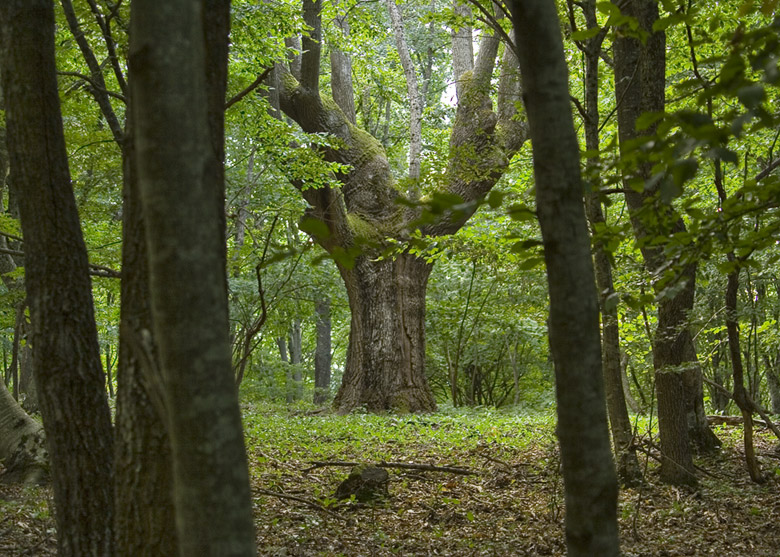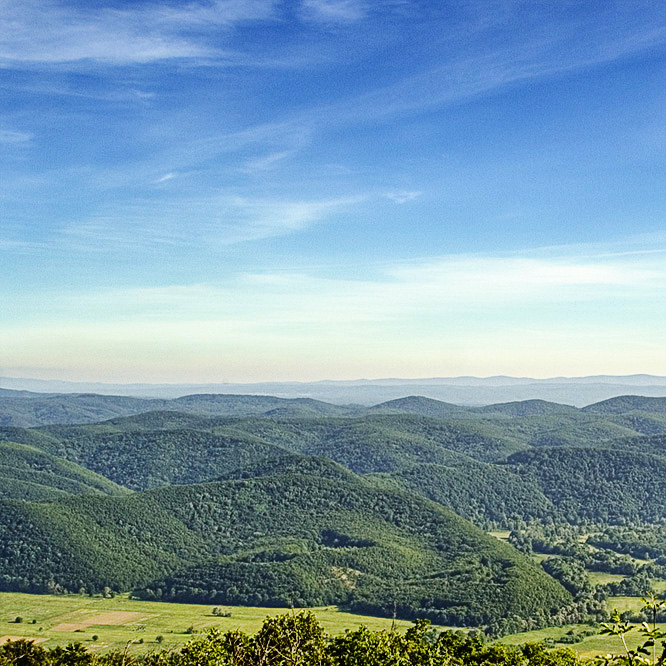|
Quercus Hartwissiana
''Quercus hartwissiana'', the Strandzha oak ( bg, странджански дъб), is a species of oak, native to southeastern Bulgaria, northern Asia Minor along the Black Sea, and the Caucasus. It was described by the Finnish-born Russian botanist and entomologist Christian von Steven in 1857. Description ''Quercus hartwissiana'' is a large deciduous tree, reaching heights of , with umbrella-shaped crown and ascending branches. The bark is thick, finely furrowed, almost black. The shoots are dark reddish-brown and bald. The buds are broad, oval or almost round, long, with short burnished scales. The petiole is long. The leaves are long and 7 to 9 cm wide, slightly convex in the base, and have seven to ten pairs of fairly regular, short, rounded to pointed lobes. The leaf veins are all directed into the lobes of the leaf, not into the indentations between them. The top of the leaf is bright green, the underside is dull, with a dark brown shading, with fine fleece and so ... [...More Info...] [...Related Items...] OR: [Wikipedia] [Google] [Baidu] |
Nicolai Anders Von Hartwiss
Nicolai Anhorn von Hartwiss (Николай Андерс фон, ''де'' Гартвис, ''Николай Андреевич''; was a Livonian-born, Baltic German, Russian botanist, plant explorer and plant breeder. His education at the university in Dorpat (Livonia) was interrupted by the Napoleonic Wars 1812–1818 when he served in the Russian army. Afterwards he worked on his father's estate and by 1824 was living in Riga and had a collection of 500 varieties of fruit trees and roses. He was then appointed to the Russian Imperial Botanical Garden at Nikita where he served as a director for the rest of his career. He is remembered for his plant collection explorations of Georgia and the Crimea, and for the breeding of roses. Life Von Hartwiss was born Ritter (esquire) Nikolaus Ernst Bartholomäus Anhorn von Hartwiss, ''Hartwiß'' in 1793 at his father's estate at Kokenhof near Wolmar, Livonia (now Valmiera, Latvia). The family Anhorn von Hartwiss (double name) comes from Sw ... [...More Info...] [...Related Items...] OR: [Wikipedia] [Google] [Baidu] |
Christian Von Steven
Christian von Steven (russian: Христиан Христианович Стевен - Khristian Khristianovich Steven; 19 January 1781, in Fredrikshamn, Vyborg Governorate – 30 April 1863, in Simferopol, Crimea) was a Finnish-born Russian botanist and entomologist. Life Steven was of Swiss descent. At the age of 57 he married a young widow, Marie Karlovna Gartzewitsch (née Hagendorff), with whom he had five children: *Anton (b. 12 December 1835) - a Lieutenant in the Russian Navy, present at the Siege of Sevastopol (1854–1855) *Julia (24 August 1837 – 1855) *Natalia (27 August 1839 – 1862) - married Lieutenant Colonel Hippenreiter *Alexander (1844-1910) *Katharina (b. 16 August 1841) Career He studied at the Royal Academy of Turku, Sweden, now Finland, and at Jena, Germany, before studying medicine at Saint Petersburg University. The senior Russian sericulture (silk farming) inspector Friedrich August Marschall von Bieberstein employed Steven as his assistant ... [...More Info...] [...Related Items...] OR: [Wikipedia] [Google] [Baidu] |
Biome
A biome () is a biogeographical unit consisting of a biological community that has formed in response to the physical environment in which they are found and a shared regional climate. Biomes may span more than one continent. Biome is a broader term than habitat and can comprise a variety of habitats. While a biome can cover large areas, a microbiome is a mix of organisms that coexist in a defined space on a much smaller scale. For example, the human microbiome is the collection of bacteria, viruses, and other microorganisms that are present on or in a human body. A biota is the total collection of organisms of a geographic region or a time period, from local geographic scales and instantaneous temporal scales all the way up to whole-planet and whole-timescale spatiotemporal scales. The biotas of the Earth make up the biosphere. Etymology The term was suggested in 1916 by Clements, originally as a synonym for '' biotic community'' of Möbius (1877). Later, it gained its c ... [...More Info...] [...Related Items...] OR: [Wikipedia] [Google] [Baidu] |
Quercus Cerris
''Quercus cerris'', the Turkey oak or Austrian oak, is an oak native to south-eastern Europe and Asia Minor. It is the type species of ''Quercus'' sect. ''Cerris'', a section of the genus characterised by shoot buds surrounded by soft bristles, bristle-tipped leaf lobes, and acorns that usually mature in 18 months. Description ''Quercus cerris'' is a large deciduous tree growing to tall with a trunk up to in diameter. The bark is dark gray and deeply furrowed. On mature trees, the bark fissures are often streaked orange near the base of the trunk. The glossy leaves are long and 3–5 cm wide, with 6–12 triangular lobes on each side; the regularity of the lobing varies greatly, with some trees having very regular lobes, others much less regular. The flowers are wind-pollinated catkins, maturing about 18 months after pollination; the fruit is a large acorn, long and 2 cm broad, bicoloured with an orange basal half grading to a green-brown tip; the acorn cup ... [...More Info...] [...Related Items...] OR: [Wikipedia] [Google] [Baidu] |
Quercus Pubescens
''Quercus pubescens'', the downy oak or pubescent oak, is a species of white oak (genus ''Quercus'' sect. ''Quercus'') native to southern Europe and southwest Asia, from northern Spain (Pyrenees) east to the Crimea and the Caucasus. It is also found in France and parts of central Europe. Description ''Quercus pubescens'' is a medium-sized deciduous tree growing up to . Forest-grown trees grow tall, while open-growing trees develop a very broad and irregular crown. They are long-lived, to several hundred years, and eventually grow into very stout trees with trunks up to in diameter. Open-grown trees frequently develop several trunks. The Bark (botany), bark is very rough, light gray and divided into small flakes. Large trees develop very thick whitish bark cracked into deep furrows, similar to the pedunculate oak but lighter in colour. The twigs are light purple or whitish, with tomentum. The buds are small () and blunt, light brown. The leaves are leathery usually long (rar ... [...More Info...] [...Related Items...] OR: [Wikipedia] [Google] [Baidu] |
Sorbus Torminalis
''Sorbus torminalis'', with common names wild service tree, chequers, and checker tree, is a species of tree in the mountain Fraxinus, ash or rowan genus (''Sorbus'') of the rose family (Rosaceae), that is native to Europe, parts of northern Africa and western Asia. Description It is a medium-sized deciduous tree growing to tall, with a trunk up to in diameter. The Bark (botany), bark is smooth and grayish, but flaky, peeling away in squarish plates to reveal darker brown layers. The leaves are long and broad with a petiole, dark green on both sides, with five to nine acute lobes; the basal pair of lobes are spreading, the rest more forward-pointing and decreasing in size to the leaf apex, and with finely toothed margins; the undersides have small hairs when young, but both sides are smooth and shiny when older; the autumn colour is yellow to red-brown. The flowers are in diameter, with five white petals and 20 creamy-white stamens; they are produced in corymbs diameter in ... [...More Info...] [...Related Items...] OR: [Wikipedia] [Google] [Baidu] |
Fagus Orientalis
''Fagus orientalis'', commonly known as the Oriental beech, is a deciduous tree in the beech family Fagaceae. It is native to Eurasia, in Eastern Europe and Western Asia. Description ''Fagus orientalis'' is a large tree, capable of reaching heights of up to tall and trunk diameter, though more typically tall and up to trunk diameter. The leaves are alternate, simple, and entire or with a slightly crenate margin, long and broad, with 7–13 veins on each side of the leaf (6–7 veins in ''F. sylvatica''). The buds are long and slender, long and thick, but thicker, till , where the buds include flower buds. The flowers are small catkins which appear shortly after the leaves in spring. The seeds are small triangular nuts long and wide at the base; there are two nuts in each cupule, maturing in the autumn 5–6 months after pollination. The cupule differs from that of European Beech in having flattened, slightly leaf-like appendages at the base (slender, soft spines in ... [...More Info...] [...Related Items...] OR: [Wikipedia] [Google] [Baidu] |
Carpinus Betulus
''Carpinus betulus'', the European or common hornbeam, is a species of tree in the birch family Betulaceae, native to Western Asia and central, eastern, and southern Europe, including southern England. It requires a warm climate for good growth, and occurs only at elevations up to . It grows in mixed stands with oak, and in some areas beech, and is also a common tree in scree forests. Hornbeam was also known as 'Yoke Elm'. Description It is a deciduous small to medium-size tree reaching heights of , rarely , and often has a fluted and crooked trunk. The bark is smooth and greenish-grey, even in old trees. The buds, unlike those of the beech, are long at the most, and pressed close to the twig. The leaves are alternate, long, with prominent veins giving a distinctive corrugated texture, and a serrated margin. It is monoecious, and the wind-pollinated male and female catkins appear in early summer after the leaves. The fruit is a small long nut, partially surrounded by a thre ... [...More Info...] [...Related Items...] OR: [Wikipedia] [Google] [Baidu] |
Rezovo (river)
The Rezovo (also Rezovska, Rezvaya and Rezve; bg, Резовска река ; tr, Mutludere ) is a river in the extreme southeast of Bulgaria and northernmost part of European Turkey. The river is situated in Bulgaria's Strandzha Nature Park. River basin The Rezovo is 112 km long and its source is in the Turkish part of the Strandzha mountains east of Kofçaz in Turkey under the Turkish name of ''Paspalderesi''. It generally flows east from Turkey to Bulgaria, and after Paspala village of Kırklareli Province in Turkey becomes a border river between the Turkey and Bulgaria until its mouth in the Black Sea at Rezovo. This location constitutes the southernmost point of the Bulgarian Black Sea Coast and the northernmost point of the Turkish one, as well as the southeasternmost point of Bulgaria and northeasternmost point of Turkish Thrace. The Rezovo's catchment spreads over 739 km2, of which 555 km2 are in Turkey, and 184 km2 in Bulgaria. [...More Info...] [...Related Items...] OR: [Wikipedia] [Google] [Baidu] |
Veleka
The Veleka ( , ) is a river in the very southeast of Bulgaria (Burgas Province), as well as the very northeast of European Turkey. It is 147 km long, of which 108 km lies in BulgariaStatistical Yearbook 2017 , p. 17 and 25 km lie in Turkey, and has its sources from a number of springs in the Turkish part of the (İstranca) mountains. ... [...More Info...] [...Related Items...] OR: [Wikipedia] [Google] [Baidu] |
Strandzha
Strandzha ( bg, Странджа, also transliterated as ''Strandja'', ; tr, Istranca , or ) is a mountain massif in southeastern Bulgaria and the European part of Turkey. It is in the southeastern part of the Balkans between the plains of Thrace to the west, the lowlands near Burgas to the north, and the Black Sea to the east. Its highest peak is Mahya Dağı ( bg, Махиада, ''Mahiada'') () in Turkey, while the highest point on Bulgarian territory is Golyamo Gradishte ( bg, Голямо Градище) (). The total area is approximately . The name of the massif allegedly derives from Istranca, the former name of the municipality of Binkılıç in Çatalca district, Istanbul Province, Istanbul province. Geography and climate The climate of the area is considerably influenced by the Black Sea and is predominantly humid continental in the mountains and humid subtropical at the coast. Major rivers in the area are the Veleka ( long) and the border river Rezovska ( long). ... [...More Info...] [...Related Items...] OR: [Wikipedia] [Google] [Baidu] |
Strandzha Nature Park
Strandzha Nature Park ( bg, Природен парк Странджа ''Priroden park Strandzha'', also transliterated as Stranja Nature Park) is the List of protected areas of Bulgaria, largest protected area in Bulgaria spanning a territory of in the Strandzha Mountain in the extreme south-eastern corner of the country on the border with Turkey. It was established on 25 January 1995 to protect ecosystems and biodiversity of European importance, as well as the traditional cultural, historical and folklore heritage of the region. The altitude varies from on Gradishte Peak to at the Bulgarian Black Sea Coast, Black Sea coast with average length of from west to east and from north to south. The nature park is situated in Burgas Province with two towns, Malko Tarnovo and Ahtopol, and several villages within its territory. It includes five nature reserves: Silkosiya Reserve, Silkosiya, Sredoka Reserve, Sredoka, Tisovitsa Reserve, Tisovitsa, Uzunbodzhak Reserve, Uzunbodzhak and ... [...More Info...] [...Related Items...] OR: [Wikipedia] [Google] [Baidu] |









